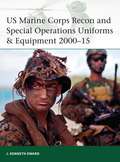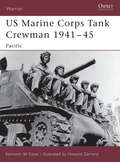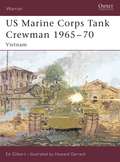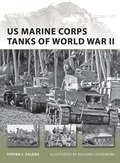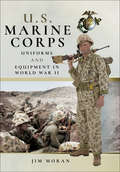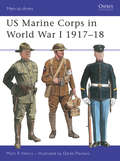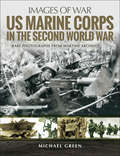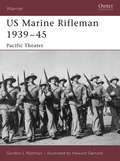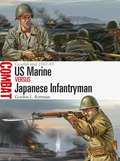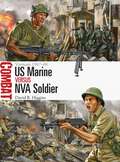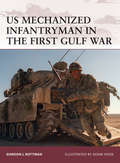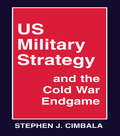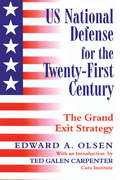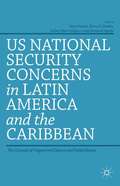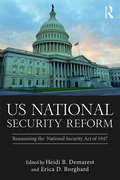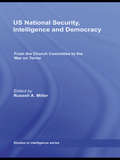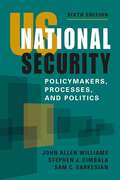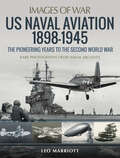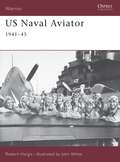- Table View
- List View
US Marine Corps Recon and Special Operations Uniforms & Equipment 2000-15
by J. Kenneth EwardIn the age of modern warfare the changing landscape of the 21st century battlefield has demanded a transformation within the US Marine Corps Special Operations. Adapting to a huge range of combat environments, an enormous array of specialist uniforms, protective armor and battlefield electronic devices have been developed to facilitate missions in the most extreme conditions. A special forces operator may now have available to him a dozen distinct types of body armor and two dozen different weapons; never before in American military history has so much been given to so few. Authored by J. Kenneth Eward, professor at the American Military University, and illustrated throughout with official and private photographs and meticulous color plates, this volume offers the first detailed, authoritative study of the characteristics, and the performance in the field, of the most modern combat gear and weapons provided for USMC specialist operators to date.
US Marine Corps Tank Crewman 1941-45
by Howard Gerrard Kenneth EstesThe ferocity of the Pacific war almost defied the available military technology. In this environment the evolving use of tanks by the US Marine Corps played a significant role; at the end of the Battle of Okinawa, Major General Lemuel Shepherd wrote in his report that 'if any one supporting arm can be singled out as having contributed more than any others during the progress of the campaign, the tank would certainly be selected.' This book traces the history of the US Marine Corps tank crewman, including the significant changes in doctrine, equipment, and organization that World War II brought, and his experience fighting in the Pacific theater.
US Marine Corps Tank Crewman 1965-70
by Howard Gerrard Oscar GilbertBy 1960, following Korea, tanks and their crews had proved themselves to be a fundamental part of the Marine Corps' combined arms team. When the Marines were ordered to Vietnam in 1965, they took their tanks with them. This book explores this decision, which created a political storm. The presence of the tanks became a lightning rod for accusations of an 'escalation' of the war. Nevertheless, the tanks not only proved their value in the anti-guerrilla campaigns, but also amid the bitter conventional fighting and extraordinary casualties at Hue City. The ability to undertake such radical change and to prevail demonstrated the versatility, courage and tenacity that are the hallmarks of the 'ordinary' Marine.
US Marine Corps Tanks of World War II
by Steven Zaloga Richard ChasemoreThe US Marine Corps formed six tank battalions in World War II which saw combat in some of the most varied and extreme conditions of the Pacific theater. The Marine tank battalions fought on small coral atolls such as Tarawa, in the fetid jungles of the south west Pacific including Guadalcanal, in the lush central Pacific islands of the Marianas such as Saipan and Guam, and on the volcanic deserts of the Bonin islands such as Iwo Jima. The tank equipment of the Marine Corps was essentially the same as that used by the US Army: the M3 and M5A1 light tanks, and the M4 Sherman medium tanks. But the conditions and the opponent forced the Marine Corps to adapt both in terms of technical and tactical innovations. The numerous island landings forced the development of novel landing equipment, especially deep wading equipment to get the tanks safely ashore. Japanese defensive tactics in 1943-44 put a premium on American use of flamethrowers and the development of a variety of flamethrower tanks on the M3 light tank chassis. Deadly Japanese close-infantry tactics forced the development of novel methods of tank protection including the use of wooden armor to defeat the use of magnetic anti-tank devices. This book will examine the Marine use of tanks in World War II and the tactics and technology that made their experiences so unique in the annals of tank warfare.
US Marine Corps Uniforms and Equipment in World War II: 'they Are Marines' - Uniforms And Equipment In The Second World War Ii
by Jim MoranThe United States Marine Corps was one of the phenomena of the Second World War. Greatly expanded from its prewar order of battle of scattered defense battalions, overseas garrisons and ship detachments, it became a multi-division force bearing the brunt of the hardest fighting across the whole vast expanse of the Pacific theater of operations. In August 1942 Marines were among the first to strike back at the Japanese in the jungles of Guadalcanal; Marine Raider battalions were formed to carry the fight to the enemy; and from the Central Solomon's landings of mid–1943 it was the Marines who spearheaded the 'island hopping' amphibious campaign which brought them to Okinawa, on Japan's doorstep, by VJ-Day. This epic story has been well documented in most respects except one: the uniforms, insignia and personal equipment of the Marines who fought their way across the Pacific. Authoritative, illustrated reference works of this important aspect of World War II's physical history have been notoriously lacking. In this book, longtime collector and researcher Jim Moran fills the gap, with a systematic, detailed guide illustrated with more than 300 photographs, including some 200 close-ups of surviving items in private collections on both sides of the Atlantic. The author covers service and field uniforms at the outbreak of war; the development of the Marine's dungaree's; the introduction and development of the camouflage uniforms which became the Marine's trademark in the popular imagination; the 782 gear webbing equipment; the various packs and other load-carrying items; the uniforms, insignia and equipment special to the elite Marine Raiders and Paramarines; the uniforms and accouterments of the US Marine Corps Women's Reserve; and a range of issue and personal small kit items which collectors may encounter. His research is supported by some 100 wartime photographs showing the identified item in use. Assisted and encouraged by the US Marine Corps Historical Center at Quantico, Virginia, Jim Moran has produced an essential reference for the collector, modeler, illustrator and uniform historian.
US Marine Corps and RAAF Hornet Units of Operation Iraqi Freedom
by Tony Holmes Chris DaveySome 84 of the 250 Hornets committed by Central Command to Operation Iraqi Freedom (OIF) proudly bore MARINE titling on their rear fuselages. A further 14 were marked with the distinctive kangaroo roundel of the Royal Australian Air Force (RAAF). The exploits achieved by the units that flew these jets into combat is detailed in this volume, the third of three titles published in the Combat Aircraft series on what has been dubbed by many TACAIR insiders the 'Hornet's War'. Although the bulk of this book deals with the major hostilities phase of OIF I, which ran from 20 March to 20 April 2003, the decade of pre-war OSW missions and ongoing post-war OIF II operations are also covered in significant detail from the Marine Corps perspective. Profusely illustrated with rare frontline photography and more than 30 specially commissioned colour artworks, this book also features the combat experiences of 24 pilots and Weapons Systems Officers.
US Marine Corps in World War I 1917-18
by Mark HenryThough the US Marines initially struggled to maintain their distinctive identity within the huge American Expeditionary Force in France, their unforgettable performance at Belleau Wood, Soissons, St Mihiel, Blanc Mont and the Meuse-Argonne established their reputation as 'the most aggressive body of diehards on the Western Front'. This book describes the organization of this formidable force during World War II, from 1917 to 1918, and details their uniforms, insignia and decorations, weapons and equipment. Numerous photographs and eight full colour plates vividly depict the various ranks of the US Marine Corps.
US Marine Corps in the Second World War: Rare Photographs From Wartime Archives (Images of War)
by Michael GreenThe United States Marine Corps played a leading role in the war against Japan from Pearl Harbor in December 1941 until VJ Day on September 2, 1945. Living up to its motto the "First to Fight," the 1st Marine Division landed on the Japanese-occupied island of Guadalcanal in the south Pacific on August 7, 1942 and fought its way up the central Solomon Island to Cape Gloucester in the territory of New Guinea.In October 1942, the Marine Corps captured Tarawa Atoll and so began their advance across the central Pacific, fighting many famous and bloody battles such as Saipan, Tinian, Guam, Iwo Jima, and finally the 82-day epic struggle for Okinawa. These victories came at high cost, with 19,737 Marine killed and 67,207 wounded.This classic Images of War title presents a graphic overview of the Corps' legendary campaign in text and contemporary images. The author expertly describes the full range of Marine Corps weaponry and explains their organization, tactics, and fighting doctrine.
US Marine Infantry Combat Uniforms and Equipment 2000-12
by Kenneth Ewald J. EwardThe US Marine Corps has been a key part of the US presence in a host of combat zones in the first years of the 21st century, from Iraq to Afghanistan. With a front-line strength of over 200,000 active-duty personnel, the USMC is significantly larger than the entire armed forces of some countries. It fulfils a vital component of the United States' military capability, uniquely being able to deploy a combined-arms task force to almost anywhere across the globe in a matter of days. The infantry role is at the heart of USMC thinking; all Marines are trained as riflemen, and other components of the USMC, such as Marine aviation, have always been tasked first and foremost with supporting the infantry on the ground.While sharing some weapons systems with the US Army, US Navy, and US Air Force, the Marine Corps has developed its own distinctive approach to matters of dress, personal equipment and armament. Since the year 2000 the "profile" of the Western combat infantryman has changed greatly. The most important trends are a new generation of camouflage clothing, body armor, personal electronics, and night-vision equipment, which have transformed the appearance and capability of the individual rifleman. Another trend is the increased presence of women on the battlefield, which has design implications. The men and women of the USMC have been at the forefront of these developments, utilizing innovative items of dress and equipment during their extensive service in a range of challenging environments across the world.Featuring specially commissioned full-color artwork and detailed photographs, this book explores the USMC's key contribution to the development of the combat infantry soldier's clothing and personal equipment in the 21st century.
US Marine Rifleman 1939-45
by Howard Gerrard Gordon RottmanOsprey's study of United States Marine Corps riflemen during World War II (1939-1945). It is sometimes a basic assumption that a US Marine Corps rifleman was essentially trained, uniformed, equipped, and armed much the same as a US Army rifleman during World War II. While there were of course similarities, the Marines conducted their own unique training programs, wore mostly different uniforms and equipment, and possessed some unique weapons, although they also used many of the same weapons as the Army. The Marine Corps was not part of the Navy, but a component of the Navy Department alongside the Navy. While the Marines specialized in amphibious warfare, the Army actually conducted more amphibious assaults in the Pacific than the Marines. The typical Marine was extremely proud of his service and acutely aware that there were only six Marine divisions but 89 Army divisions. The Marine Corps began World War II with less than 66,000 officers and men; more than that would be wounded before it ended. The Corps grew to almost 487,000. It provided only 5 percent of the US armed forces, but suffered 10 percent of overall American casualties.The Marines were able to build on their proud traditions and history to transform a small branch of service into a premier combined arms amphibious assault force. Regardless of its expansion by 750 percent, the Corps was able to maintain its sense of tradition, instill that into thousands of new Marines, and create an elite arm of service. Here, Gordon L Rottman, follows the Marine rifleman through his draft and training, and then participation in operations such as Roi-Namur in the Marshall Islands, Saipan and Tinian in the Mariana Islands, and Iwo Jima.The opening sentences of the Marine Creed, composed shortly after the attack on Pearl HarborThis is my rifle. There are many like it, but this one is mine. It is my life. I must master it as I must master my life. Without me my rifle is useless. Without my rifle, I am useless.
US Marine Rifleman in Vietnam 1965-73
by Ramiro Bujeiro Charles MelsonThis volume provides an in-depth look at the experience of the ordinary US marine 'grunt' in Vietnam. Organisation of the corps, weaponry, equipment, uniforms, training and medical arrangements are all discussed. However, where this book differs from other similar works is not only in the detail that it goes into but also in the unifying theme of examining all these differing aspects of marine life from the point of view of a soldier serving in the conflict. The author, Charles Melson, actually served in the Vietnam War (1955-1975), and it is this personal experience that allows him to provide such a unique angle on the subject.
US Marine vs Japanese Infantryman: Guadalcanal 1942-43
by Gordon Rottman Johnny ShumateThe bitter six-month struggle for control of Guadalcanal in the South Pacific during World War II matched the US Marine Corps against the Imperial Japanese Army in a campaign that would test both sides to the limit. In this book the realities of prolonged warfare in an unforgiving environment are documented in photographs, specially commissioned artwork, official reports, and first-hand accounts, offering a glimpse of infantry combat in World War II's Pacific Theater.The toughness of American Marines was sorely tested by Japanese troops willing to lay down their lives in Banzai charges and desperate last stands across the Pacific in World War II. This book offers key insights into the tactics, leadership, combat performance, and subsequent reputations of six representative USMC and IJA infantry battalions pitched into three pivotal actions that determined the course of the campaign for Guadalcanal at the height of World War II.Mountainous and covered in tropical jungle, Guadalcanal is the largest of the Solomon Islands. During World War II its location - dominating vital lines of communication and supply between the United States, Australia, and New Zealand - made it a key strategic objective for both sides in the escalating struggle for the South Pacific region. Between August 7, 1942 and February 9, 1943 it was the setting for a series of bitter battles between the advancing Japanese forces and those of a resurgent United States and its allies, in the Allies' first major offensive against the Japanese.Spearheading the Allied effort to take and hold Guadalcanal, the US Marine Corps played a key role in the back-and-forth land battles for this vital island, while their adversaries, the garrison troops of the Imperial Japanese Army, strove to counter the Allies' offensive moves. From the initial US landings that took the Japanese by surprise to the savage battles of Tenaru, Edson's Ridge, Henderson Field, and Mount Austen, the campaign tested the infantrymen of both sides to the limit, with tropical diseases, supply problems, hostile terrain, and poor weather all adding to the horrors of close-quarter combat.
US Marine vs NVA Soldier: Vietnam 1967-68
by Johnny Shumate David HigginsIn 1967-68, the United States Marine Corps (USMC) was on the front line of the defense of South Vietnam's Quang Tri province, which was at the very heart of the Vietnam conflict. Facing them were the soldiers of the North Vietnamese Army (NVA), men whose organization and equipment made them a very different opponent from the famous, irregular Viet Cong forces. From the "Hill Battles" in April 1967 to the struggle for the city of Huế (January-March 1968) this bloody campaign forced the two sides into a grueling trial of strength. The USMC held a general technological and logistical advantage - including close air support and airborne transport, technology, and supplies - but could not always utilize these resources effectively in mountainous, jungle, or urban environments better known by their Vietnamese opponents. In this arresting account of small-unit combat, David R. Higgins steps into the tropical terrain of Vietnam to assess the performance and experience of six USMC and NVA units in three savage battles that stretched both sides to the limit.
US Marines Alphabet Book
by Jerry Pallotta Sammie GarnettTake a look at fascinating facts about the US Marines--one for each letter of the alphabet! There's a lot to learn about this important branch of our armed forces.With information from both history and the modern era, each letter covers something related to the Marines. From fire teams to jets, and from Parris Island to uniforms, this book is a wealth of information that highlights the courage and commitment it takes to serve in the US Marines.
US Mechanized Infantryman in the First Gulf War
by Adam Hook Gordon RottmanOsprey's examination of the US Mechanized Infantrymen of the First Gulf War (1990-1991), In many ways the end of the Vietnam War left the US army a spent force. Plagued by low morale, drug and race issues, and terrible public relations, the army faced an uphill climb in the effort to rebuild itself. The story of this reconstruction is mirrored in the rise of the Mechanized Infantryman. Deciding that the key to future conflict lay in highly trained and mobile warriors that could be delivered quickly to battle, the army adopted the mechanized infantryman as its frontline troops. This new, all-volunteer force was given the best training and equipment that money could buy. Most notably, they were to be deployed onto the battlefield from the new M2 Bradley Armored Fighting Vehicle.This new breed of American warriors got their first test in the First Gulf War. Fighting in the deserts of Kuwait and Iraq, these soldiers proved that the US Army was once again a force with which to be reckoned. This book tells the complete story of the rise of the US mechanized infantryman, focusing on his recruitment, training, lifestyle and combat experiences in Iraq.From the Trade Paperback edition.
US Military Innovation since the Cold War: Creation Without Destruction (Strategy and History)
by Harvey Sapolsky Benjamin Friedman Brendan GreenThis book explains how the US military reacted to the 'Revolution in Military Affairs' (RMA), and failed to innovate its organization or doctrine to match the technological breakthroughs it brought about. Many called for the transformation of the US military in the years after the end of the Cold War, seeking the changes in organization and doctrine that would complete the RMA innovation and a commitment to counter-insurgency, peace keeping and nation building missions. This volume describes the origins, uses, and limits of the RMA technologies, examines how each of the five US armed services (categorising the Special Operations as a separate service) made their adjustments both to the technologies and the use of force, and how the role of the civilian officials and the defense industry altered in this process of change and avoidance of change. The book examines the internal politics of the services as well as civil/military relations to identify the external pressures on the services for significant change in their doctrine and weapons. Many have noted the failure of the services to innovate in what can be called the 'Second Inter-war Period' (the years after the Cold War). This book offers explanations for this failure and arguments about the possible range and desirability of military innovation in the post-Cold war era. This book will be of great interest to students of strategic studies, US defence politics, military studies, and US politics. Harvey M. Sapolsky is Professor of Public Policy and Organization in the Department of Political Science at MIT and former Director of the Security Studies Program. Benjamin H. Friedman is a Research Fellow in Defense and Homeland Security Studies at the Cato Institute and a Ph.D. Candidate in Political Science at MIT. Brendan Green is a Ph.D. Candidate in Political Science at MIT and an affiliate of the Security Studies Program.
US Military Strategy and the Cold War Endgame
by Stephen J. CimbalaAt the end of the Cold War security concerns are more about regional and civil conflicts than nuclear or Eurasian global wars. Stephen Cimbala argues that deterrence characteristics of the pre-Cold War period will in the 21st century again become normative.
US National Defense for the Twenty-first Century: Grand Exit Strategy
by Edward A. OlsenThis provocative critique of Washington's current security policies, draws on the arguments made by an array of non-interventionist and conservative-nationalist scholars. It provides a blueprint for a more restrained and unilateral US role in global affairs.
US National Security Concerns in Latin America and the Caribbean
by Harry E. Vanden Gary Prevost Carlos Oliva Campos Luis Fernando AyerbeThe concepts of 'ungoverned spaces' and 'failed states' where the limited presence of the state is seen as a challenge to global security have generated a rich intellectual debate in recent years. In this edited volume, scholars from Latin America and the United States will analyze how US foreign policy making circles have applied the concepts to the creation of new US security initiatives in the Latin American region during the post September 11, 2001 era. The extension of concepts to Latin America has been significant because it has meant that during the past thirteen years US policy in the Hemisphere has shifted away from the primarily economic emphasis of the 1990s, the era of the Free Trade Area of the Americas project, back to a security focus reminiscent of the Cold War era. The last decade has witnessed a significant increase in US military presence in the region highlighted by the re-launching of the Caribbean-based Fourth Fleet, the militarization of drug fighting efforts in Mexico, and the establishment of several new military bases in Colombia, the staunchest US ally in the region.
US National Security Reform: Reassessing the National Security Act of 1947 (Routledge Global Security Studies)
by Heidi B. Demarest Erica D. BorghardThis collection of essays considers the evolution of American institutions and processes for forming and implementing US national security policy, and offers diverse policy prescriptions for reform to confront an evolving and uncertain security environment. Twelve renowned scholars and practitioners of US national security policy take up the question of whether the national security institutions we have are the ones we need to confront an uncertain future. Topics include a characterization of future threats to national security, organizational structure and leadership of national security bureaucracies, the role of the US Congress in national security policy making and oversight, and the importance of strategic planning within the national security enterprise. The book concludes with concrete recommendations for policy makers, most of which can be accomplished under the existing and enduring National Security Act. This book will be of much interest to students of US national security, US foreign policy, Cold War studies, public policy and Internationl Relations in general.
US National Security, Intelligence and Democracy: From the Church Committee to the War on Terror (Studies In Intelligence Ser.)
by Russell MillerThis volume examines the investigation by the 1975 Senate Select Committee ( Church Committee ) into US intelligence abuses during the Cold War, and considers its lessons for the currentwar on terror. This report remains the most thorough public record of America‘s intelligence services, and many of the legal boundaries operating on US intelligence.
US National Security: Policymakers, Processes, and Politics
by Stephen J. Cimbala Sam C. Sarkesian John Allen WilliamsThe main focus of US national security policy has shifted dramatically since the years of the Obama administration, moving away from nation building and counterinsurgency efforts and toward preparing for traditional state-on-state conflict with powerful peers. The sixth edition of US National Security reflects that change. It also addresses such current issues as the impact of an increasingly partisan political process, sharp divisions in public opinion, the ongoing challenges of homeland security, and developments in cyberspace and other possible domains of future warfare. <P><P>Retaining the successful structure and approach of the previous editions, the book clearly introduces and explores the full range of actors, processes, and politics involved in maintaining US national security.
US Naval Aviation, 1898–1945: The Pioneering Years to the Second World War (Images of War)
by Leo MarriottThis pictorial history tells the story of US naval aviation from its early beginnings in the 1920s to its dominance in the Pacific theater of WWII.The Japanese attack on Pearl Harbor sank or crippled almost all of the battleships in the US Navy’s Pacific Fleet. But the fleet’s aircraft carriers survived—and soon demonstrated the power of US naval aviation. Thanks to pioneering technology and far-sighted pre-war policy, the US Navy had the necessary ships, aircraft, and crews to turn the tide of the Pacific war.With more than 200 rare photographs, Leo Marriott traces the growth of US naval aviation from the flimsy seaplanes of the first years of the twentieth century to the mighty armadas that challenged those of the Japanese and, after the carrier battles at Coral Sea and Midway, led the advance across the Pacific. Marriott puts special focus on the navy’s first aircraft carriers of the 1920s, the tremendous progress made in the decades between the wars in tactics and strategy, and the innovative design of ships and aircraft themselves.
US Naval Aviation, 1945–2003 (Images of War)
by Leo MarriottIn this the highly illustrated second volume of his history of US naval aviation, Leo Marriott takes the reader through the extraordinary developments in design and capability that transformed American aircraft and aircraft carriers after the Second World War, and he describes the succession of conflicts in which they were deployed. Increasingly, advanced jets replaced propeller-driven aircraft and nuclearpowered carriers allowed the US Navy to project American military power across the world. As the many remarkable photographs in this book show, wherever naval aviation was involved, it played a crucial role, especially in the wars in Korea and Vietnam. The vessels built in the 1940s to fight in the war against Japan gave way to a new generation of super carriers. Supersonic fighters and strike aircraft entered service – the F-8 Crusaders and F-4 Phantoms of the Vietnam era, then the F-14 Tomcat, F/A-18 Hornet and S-3 Viking of more recent times. Carrier-based helicopters became more important, first for search-and-rescue missions, then for anti-submarine warfare and for landing assault forces. Throughout this period of the Cold War the US Navy’s carriers and aviation served to demonstrate American power worldwide and to counter the threat represented by the Soviet Union’s challenge to US mastery of the seas.
US Naval Aviator
by John White Robert HargisThe US naval aviator of World War II played a pivotal part in the winning of the war. From the warm waters of the Pacific to the icy conditions of the Bering Sea (including the battle of Midway), the Naval aviator was on hand to fight the enemy in any and all conditions. Between 1940 and 1942 the training of the naval aviator lasted eleven months, divided into five separate and distinct phases. From phase one, known as the Elimination or "E" base for short, through to final assignment to a carrier based squadron, the training was demanding and unrelenting.This title examines the life and experiences of the US Naval Aviator in all three types of carrier squadron - fighters (VF), dive-bombers (VB) and the torpedo squadrons (VT). From recruitment to battle, the detail of what it was like to fly and fight for the US Navy is brought vividly to life.
